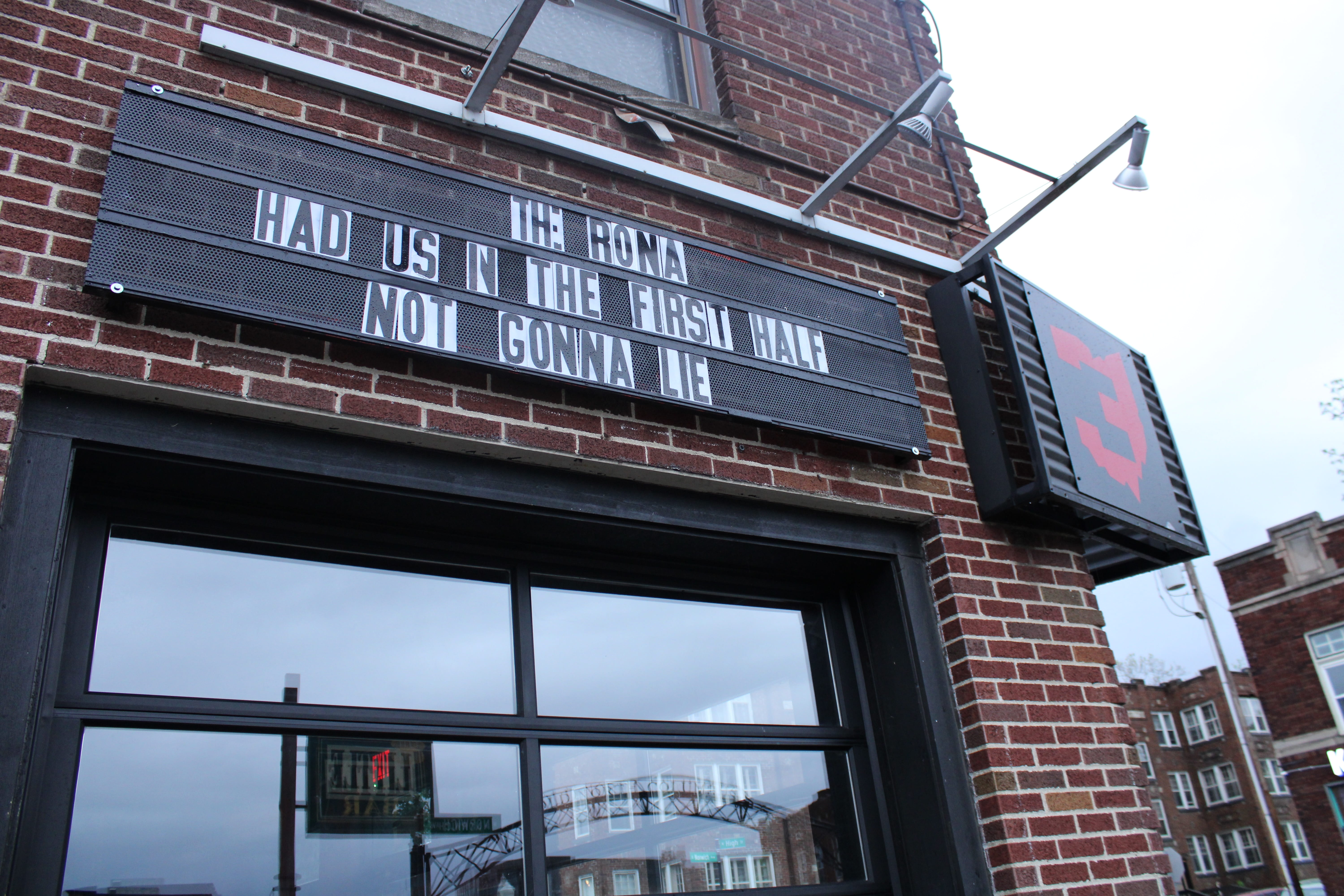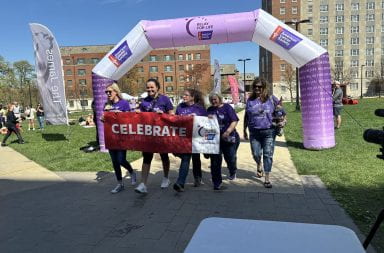
Campus bar Threes Above High is set to reopen on May 21 after being closed to patrons due to COVID-19. Credit: André White | Arts & Life Producer
When Kieran Duhl was a fourth-year in journalism in early March, she started her new job at Italian restaurant Marcella’s. She had no idea what was in store.
At that point, there had not yet been a single reported case of COVID-19 in Ohio.
Soon after, hand sanitizer was kept at the host stand to prevent the spread of germs. Then, paper menus were thrown away each night.
By March 15, all dine-in restaurants in the state were closed, and Marcella’s switched to carryout only.
Cameron Mitchell Restaurants, the fine dining company that owns Marcella’s, closed all 20 of its Columbus, Ohio, locations March 19, leading to the furlough of 4,500 employees. Duhl, an alumna as of May, was out of a job.
On March 24, Duhl applied for unemployment insurance benefits. In her application, she indicated that she was not looking for work. This made sense to her at the time, as the virus had exploded across the state, and her asthma put her at high risk from the disease.
“I’m literally depending on unemployment, and honestly unemployment isn’t enough to pay my rent, really,” she said. “I could pay my rent with unemployment, but then I wouldn’t have anything else left. It’s not just rent I have to pay for, I have utilities, I have groceries, I have student loans people calling me every day.”
The state denied her application three weeks later. She has since reapplied, but in her ninth week without a job, Duhl has received no government aid and no income. She was notified Monday that she is eligible for unemployment insurance, but she has not yet received any funds.
“I don’t like asking for help because everybody else is struggling too, you know? My dad is working his ass off trying to make ends meet, too,” Duhl said. “I’m an adult, and I have pride too, and I want to be able to take care of myself, and it’s just really frustrating right now that I can’t really do it.”
Duhl is far from the only one.
As cases of COVID-19 rose in the U.S., stay-at-home orders and bans on dine-in restaurants cost food service workers their jobs across Ohio. Restaurants struggled to remain open after switching to a carryout only model, and many closed altogether. Now, the state has a concrete timeline for reopening that started May 15, but the impact on the restaurant industry is far from over.
A Lantern analysis of industry surveys and state unemployment data shows the food service industry has been hit especially hard by the current public health crisis, with massive downturns in sales and disproportionately high unemployment rates.
When examining the effect of the pandemic on the restaurant industry, there are two stories to be told: that of the furloughed staffs and that of the struggling businesses themselves. Each paints a dire picture for the future of the industry.
The starkest example of the impact COVID-19 has had on food service workers comes from unemployment statistics. Across the country, 701,000 jobs were lost in nonfarm sectors in March, according to the Ohio Office of Budget and Management, rivaling numbers from early 2009 — the midst of the Great Recession. Of those lost jobs, 60 percent came from restaurants and bars alone.
Ohio Jobs and Family Services does not provide data on employment at restaurants and bars specifically, but does track jobs in accommodations and food services, a category that also includes hotels and cafeterias. Despite making up less than nine percent of Ohio’s workforce at the end of February, the sector lost about 26,400 jobs in March — representing two-thirds of all jobs lost across the state.
Then in April, a record-breaking 20.5 million workers lost their jobs in the United States, with more than a quarter of them coming from restaurants and bars, according to the Ohio Office of Budget and Management. There are no published state numbers for April as of yet.
Though the initial spike in restaurant job losses could be attributed to the switch from dine-in to carryout services eliminating service roles such as waiters and bartenders, kitchen staffs are also thinning as many restaurants close their doors completely.
The Ohio Restaurant Association found that nearly half of restaurant owners had already closed locations the week before Gov. Mike DeWine ordered an end to all dine-in food services March 15. Within a week, the ORA found that 1.5 percent of restaurants had closed permanently, unable to endure the financial stress in an infamously volatile industry.
Since then, the situation has only deteriorated. The ORA has found that more than one in 10 restaurants in the state currently have no plans to reopen.
“It’s unprecedented. We’ve never seen anything like this, and it’s really hard to say at this moment how it’s gonna be on the other side of this,” Homa Moheimani, the ORA’s manager of media and communications, said.
Moheimani said the ORA has been keeping close track of the industry and doing everything it can to help businesses stay afloat, but some are adjusting to the changes better than others. While the situation has actually benefited certain establishments, such as delivery-focused pizza joints, fine dining has been hit hard. She said the emphasis on a dine-in experience has made for a poor transition to delivery and carryout.
This sudden downturn comes at a time when the high-end dining industry was finding unprecedented success in Ohio. Although ORA data indicates that many restaurants go out of business each year, more are opening up, leading to a slow, steady growth in the industry. Moheimani said the association’s president and CEO has been insisting for years that the state is in a “golden age of restaurants,” with locations such as Columbus’ Short North Arts District and Cincinnati’s Over-the-Rhine attracting cutting-edge establishments.
Now, that trend could be snuffed out. While the state’s reopening plan will see patrons eating inside restaurants by Thursday, Moheimani said she thinks the shockwaves it sends through the industry will be measured in years.
“The million dollar question is ‘How long?’ right? How long are we going to be like this? How long is it gonna take to open back up?” she said. “Even if we open up today, there’s no confidence right now in gathering, for the most part.”
Duhl exemplifies these concerns about consumer confidence. Despite missing the income from her job at Marcella’s, she is more worried about the state lifting restrictions too soon.
“It’s just scary,” she said. “How can they say they’re gonna open restaurants when universities are saying they’re gonna have a full fall semester online? It’s just two very conflicting narratives and I’m like, ‘Clearly you guys are only trying to open the restaurants to help boost the economy back up,’ but at what expense? All the people who work at restaurants are worth less than all of these other people? Why do we have to put ourselves at risk?”
Restaurant owners are facing a similar dilemma in balancing the health and safety of their employees and customers with unimaginable financial losses. The campus area has become a ghost town of temporary closures. Dark windows and apologetic signs mark eateries at every level, from large franchises such as Starbucks and Bibibop Asian Grill to local favorites such as Ethyl & Tank and Threes Above High.
“We need to be open, but we also have to be open at the right time. We don’t want to rush this,” Scott Ellsworth, owner of both Threes and Fours On High, said.
Ellsworth represents a part of the food service industry that has been rocked hardest by this crisis: bars. With little to no focus on food, Ellsworth couldn’t make money at his establishments on carryout sales, and had to close completely within three weeks of the shut-down order.
Although Ohio has a plan for reopening eateries, it is one that leaves bars like his last in line.
“Put everybody 6 feet apart in here, how many people are you gonna fit in here? Twenty people? That’s not gonna help you,” he said.
In this way, the crisis stands in stark contrast to previous economic downturns. Ellsworth said campus-area establishments are usually insulated from recessions by a college crowd with low living expenses and disposable income. This safeguard proved inadequate when campus sat empty during the peak spring months, including bar-favorite events such as the spring football game and senior bar crawl.
Ellsworth said he is confident the students will be back come next football season. He isn’t able to consider the possibility of it being canceled. All he can do is prepare for reopening Thursday.
Even when fall arrives, Ellsworth said he doesn’t think he will be able to rehire all of his old staff.
“I have seven bartenders and seven door guys on a Friday and Saturday night,” he said. “When we first open back up, there’s no way we’re gonna need that.”
The sudden collapse of the food service industry is already hitting employees and owners hard, but an overwhelmed unemployment insurance system has made the situation even more dire.
Adding to the stress of a massive spike in unemployment claims, the state’s unemployment trust fund is just half as solvent as the federal government recommends. Ohio ranks seventh-lowest out of all U.S. states in unemployment trust fund solvency, according to a report from the U.S Department of Labor. The state’s unemployment trust fund is an account held by the federal government that is paid into with payroll taxes, and the trust fund is set to see more trouble as payroll taxes were far below Office of Budget and Management estimates for March.
Capri Thomas, an Ohio State alumna as of May, is one of many to fall victim to an unprepared system.
Thomas was a server at P.F. Chang’s at the Easton Town Center before she lost her job March 15. At first, she said she wasn’t going to apply for unemployment insurance benefits, as she thought others needed it more. When her mother convinced her to, she began a frustrating, days-long process.
After trudging through the overloaded online application, which frequently crashed, Thomas finally filed an unemployment insurance claim after days of trying. Then, she watched as her coworkers and friends received answers while she waited with no response. After a full day of her and her mother calling the office, she said they were able to leave a voicemail.
Thomas learned that her claim was waiting on the government of her home state of Virginia for approval. She said the office told her she would receive back pay for the wait if she was approved, but she could not apply for the separate Pandemic Unemployment Assistance through the Coronavirus Aid, Relief, and Economic Security Act until a decision was made. She said she has since been rejected for unemployment insurance and is planning to apply for PUA.
“I have to remind myself that there is literally nothing I can do right now,” Thomas said. “Literally the whole entire world is just paused.”
Without unemployment insurance benefits or a job, Thomas said she must rely on her parents for financial help. Restaurants were always a part of Thomas’ post-graduation plans as a way to supplement income while she found a full-time job. Now, she is at a loss.
“Since high school, that’s just always been my way of money, and now it’s just not an option, really, for next year,” she said.
As many wait for government assistance, some establishments have found ways to support their laid-off employees. With benefits uncertain, stimulus legislation slow-moving and bills piling, many employers have taken it into their own hands to support the workers they were forced to let go.
A&R Creative Group, a restaurant group responsible for Ethyl & Tank, Midway, TRISM, Hoof Hearted Brewing, Tobacco International, Fourth Street Bar & Grill and more, has started an online assistance fund for its employees, according to the group’s GoFundMe page, an online crowdfunding platform. In addition, the group held a free carryout lunch for 300 restaurant workers April 2.
Cameron Mitchell Restaurants donated all of the proceeds from online gift card sales from March 19-31 to its furloughed employees, according to their website. Duhl was not employed at Marcella’s long enough to receive a cut, but she said she appreciates the way the business is taking care of its long-time employees.
Ellsworth, of Threes and Fours, has found a way to help out more than just his own staff.
After raising $5,000 on GoFundMe for his furloughed employees, Ellsworth matched it with his own money to provide each with $400.
And he didn’t stop there. Ellsworth approached local apparel brand Mid High Market with the idea of releasing T-shirts sporting the logos of 23 local bars and restaurants and splitting the proceeds among the staffs of the businesses.
“A lot of them are getting screwed because they’re students. So they might be under their parents still, so they might not be getting a stimulus check, they might not be able to get unemployment,” Ellsworth said.
An exception in the federal stimulus bill excludes dependents who are legal adults from receiving the money.
After selling more than 2,400 shirts and hoodies, they were able to raise more than $43,000 for the 280 workers. Though roughly $150 is not a large sum, Ellsworth said he thinks it will do a lot to boost their morale and give them something to look forward to.
“Down the road, in the next year or two, these employees are gonna see people wearing that shirt everywhere. And I don’t know, I think that’s kinda cool,” he said. “They’re gonna know that they bought that shirt because of them, for them, to help them out.”
Now that bars and restaurants are gradually reopening, Ellsworth plans to rehire some staff. He said it will be double his normal summer staff, in order to keep Threes clean, but far less than he hires during the school year. He doesn’t anticipate it being a profitable arrangement, but he said it is better than doing nothing.
With distancing rules cutting his bar’s capacity down to just a third of its normal volume, Ellsworth said he is more worried for the fall, when campus bars would normally flood with students, making up for the inevitably slow summer months. If restrictions are still in place, he thinks it could be the final nail in the coffin for many struggling establishments.
“I feel like this pandemic that we’ve been going through is already gonna put some people out of business,” he said. “That will definitely seal the fate for some others who might be on the fence.”



